In my book a 1911 is a 1911; unless it happens to be the Kimber KDS9c Rail. This pistol, built on the 1911 platform, was designed from the ground up for defensive use. Around a year ago Kimber introduced the KDS9c; essentially a “Commander-size” pistol with a double-stack magazine in 9mm Luger, that is optics ready. It was different than most 1911-style pistols with its streamlined looks and ergonomic design. It garnered a lot of good press, but some of folks clamored for a couple of improvements. Kimber, ever mindful of their customer base, went into action.
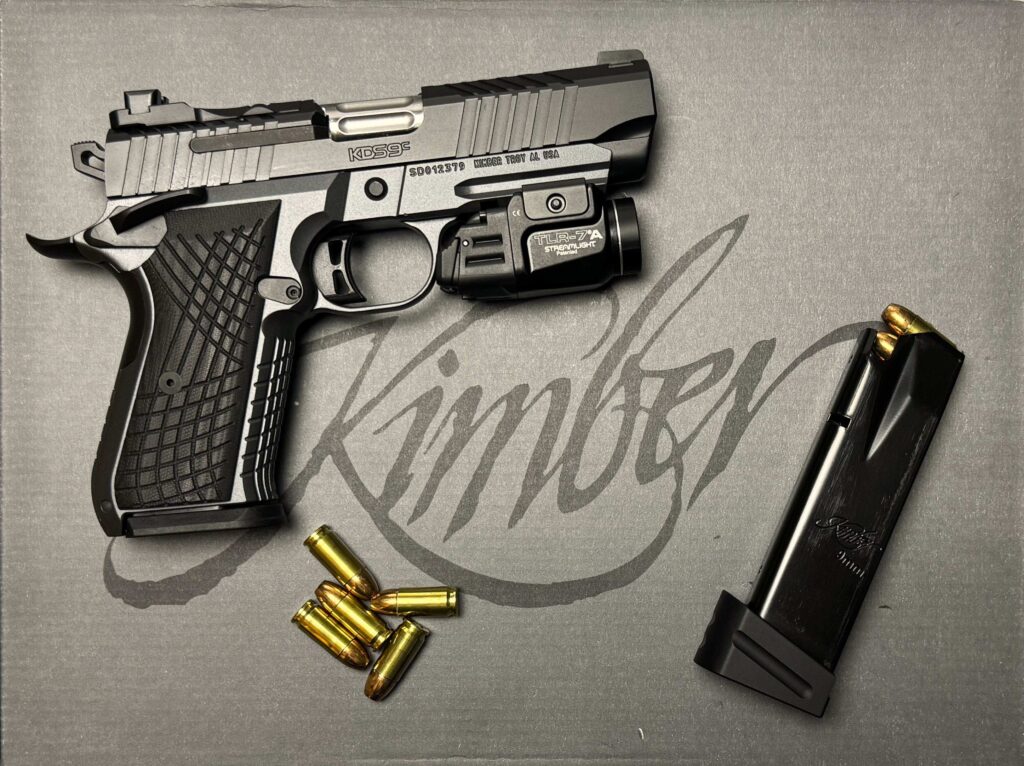
The newest handgun in the Kimber line is the KDS9c Rail, a double-stack 9mm, with an integral Picatinny rail and bilateral thumb safeties.
The result was the KDS9c was recently given a new sibling with all the attributes of the older model, but has an integral Picatinny rail on the dust cover and a bilateral thumb safety. This version was christened the KDS9c Rail. For the uninitiated, I’ll go over the commonalities of the two pistols and what sets them apart from run-of-the-mill 1911 pistols. Both Kimber’s have a frame made of 7075 Aluminum, and the slide is stainless steel. Said slide is serrated fore and aft, with an external extractor, and the top of the slide, ahead of the ejection port is serrated. The forged stainless-steel barrel, has a 1:10 left-hand twist, a 30-degree flush-cut deep crown at the muzzle, and is fluted along its length. At the muzzle, the barrel is bell-shaped to eliminate the need for a barrel bushing. The front and rear TruGlo night sights are mounted in dovetails; the rear sight is part of the optics cover plate. It slopes slightly forward, so it can be used to manipulate the slide in an emergency.
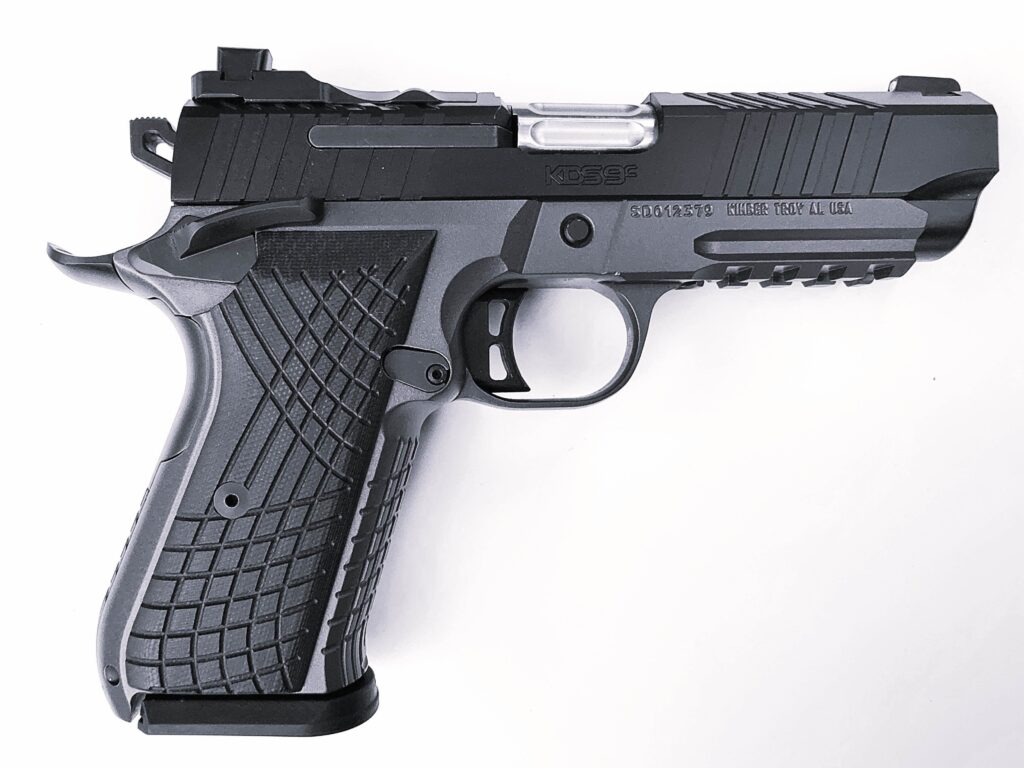
This two-tone model has a stainless-steel slide is in KimPro Black, while the aluminum frame is in KimPro Gray; the black G10 grips are crosshatch cut.
Unlike most 1911 pistols, the KDS9c Series lacks a grip safety. Some might decry this feature, but this allows the pistol to be fired, even if it is gripped improperly, but must be put into action in a hurry. To help prevent hammer bite there’s an extended tang which is part of the rounded mainspring housing assembly. This perfectly mates with back-strap of the grip frame, providing ergonomics well-suited to my medium-sized hand. Both the mainspring housing and the front of the grip frame have crosshatch cuts, as do the black G10 grip panels, which are thin and blend into the grip frame. The combination provides a comfortable and secure hold on the pistol. Rather eye-catching, the hammer is a loop-style with a kidney-shaped cut with a serrated flat at the top. The extended thumb safeties are also serrated. Pull weight on the skeletonized trigger is factory-set at 3.5-4.5 pounds; the face is about 0.25’ wide and serrated. A 16-pound flat-wire recoil spring and a full-length guide rod are nestled in the frame, and can handle the hottest loads. The oval-shaped magazine catch is in the usual location, and is reversible. The slide stop is somewhat extended, but like the rest of the controls, is unobtrusive.
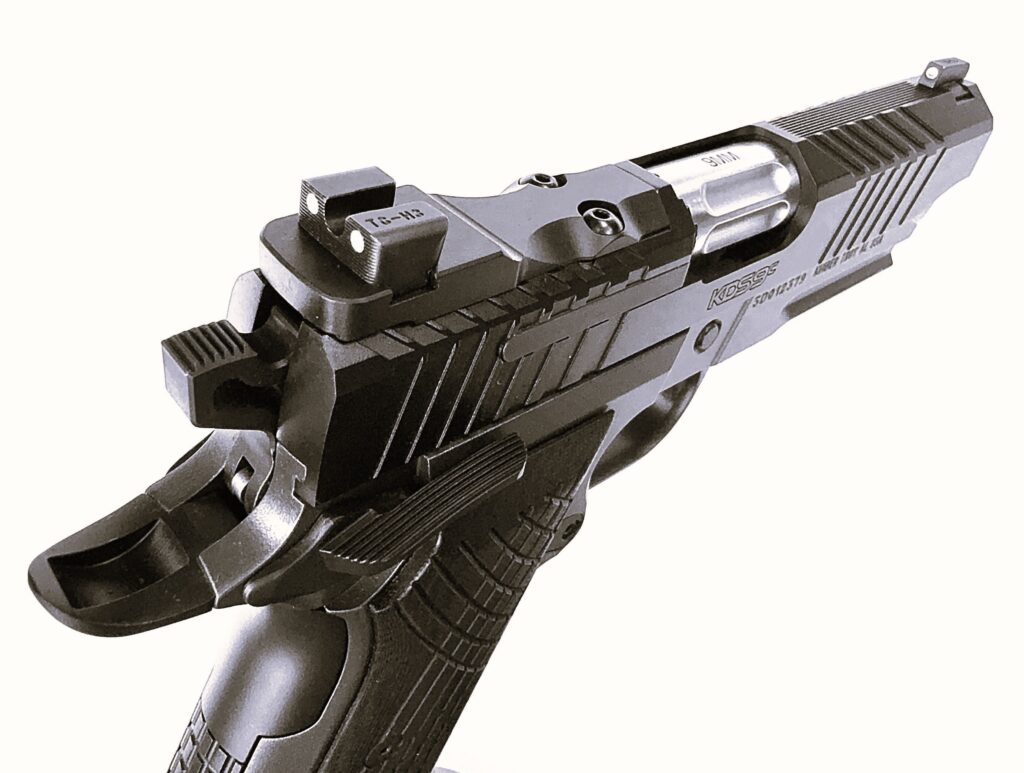
Standard equipment on the KDS9c Rail is TruGlo night sights; the rear sight is mounted on the optics cover plate; you can see the unusually-shaped hammer.
My KDS9c Rail test gun is the two-tone version, with a KimPro black slide and a KimPro gray frame. Standard equipment is a 15-round, flush-base magazine, plus an extended-base, 18-round magazine. The guns come came in a box, which also contains a gray nylon carrying case. Included is a safety padlock, hex wrenches to fit the grip panel and optic plate screws. There’s even a test target. I performed a front to rear inspection, which revealed excellent fit and finish, with no visible flaws. I found the KDS9c Rail a little easier to disassemble than the standard 1911 pistol with a barrel bushing. Skipping the bushing removal saves a step, but read the owner’s manual before disassembly. Be careful removing the recoil spring as you can unintentionally launch the recoil spring guide rod backward! Take my word for it.
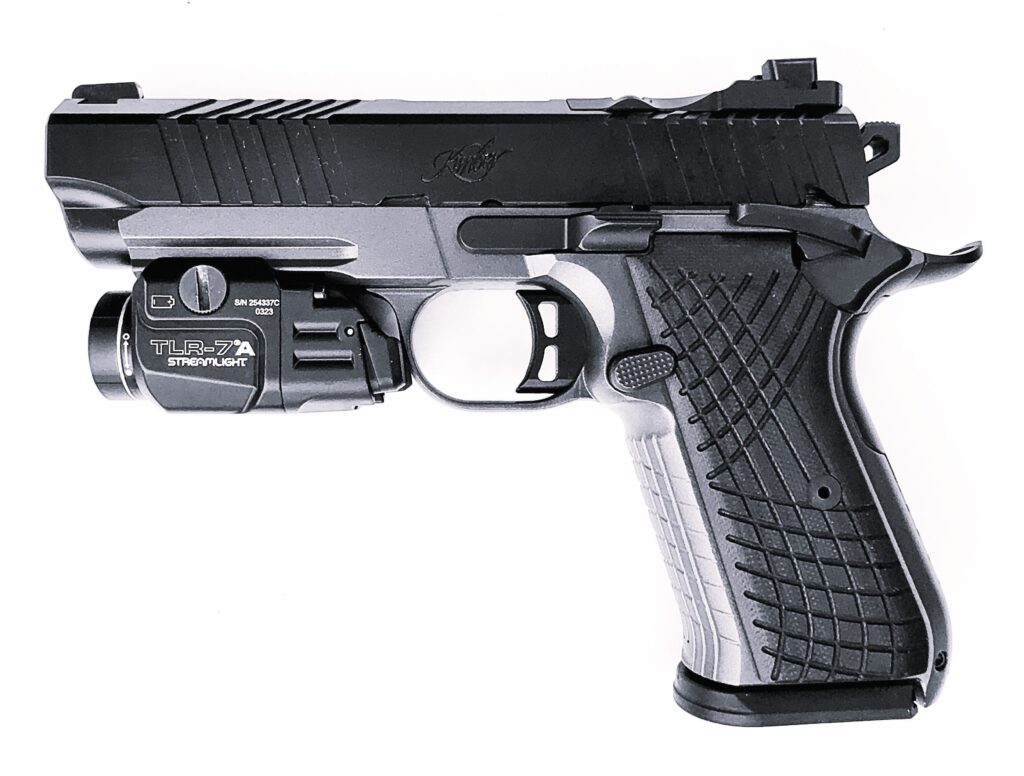
The author’s Streamlight TLR-7A tactical light flit perfectly on the KDS9c Rail; note the unobtrusive and easy to manipulate controls of the left side of the frame.
I elected to use six different 9mm loads in the KDS9c Rail T&E. This included Black Hills 100 gr. Honey Badger +P, plus their Factory New 124 gr. JHP. Next, was the Federal Train + Protect, with a “Versatile” 115 gr. JHP. From Hornady came a Subsonic load with a 147 gr. XTP-HP, and some Serbian-made PPU Range Master rounds with a 124 gr. FMJ bullet. Remington supplied their Range cartridges with a 115 gr. bullet which has an exposed lead nose, and jacket-enclosed base.
To pack the KDS9c Rail, I used an early model Alien Gear Cloak OWB holster, which was a combo of leather back, with a kydex tunnel. It works with rail-equipped 1911 pistols, but not with a tactical light mounted. I selected a Blade-Tech Signature single magazine pouch, made of kydex, and both magaziner tension and belt width are adjustable. My gun belt was the DeSantis Gunleather B35 reversible model with a 1.25” width. For a tactical light, I used a Streamlight TLR-7A Flex, which produces 500 lumens and has dual activation switches on the rear. I was impressed with the TruGlo night sights on the Kimber and decided not to use a MRDS.
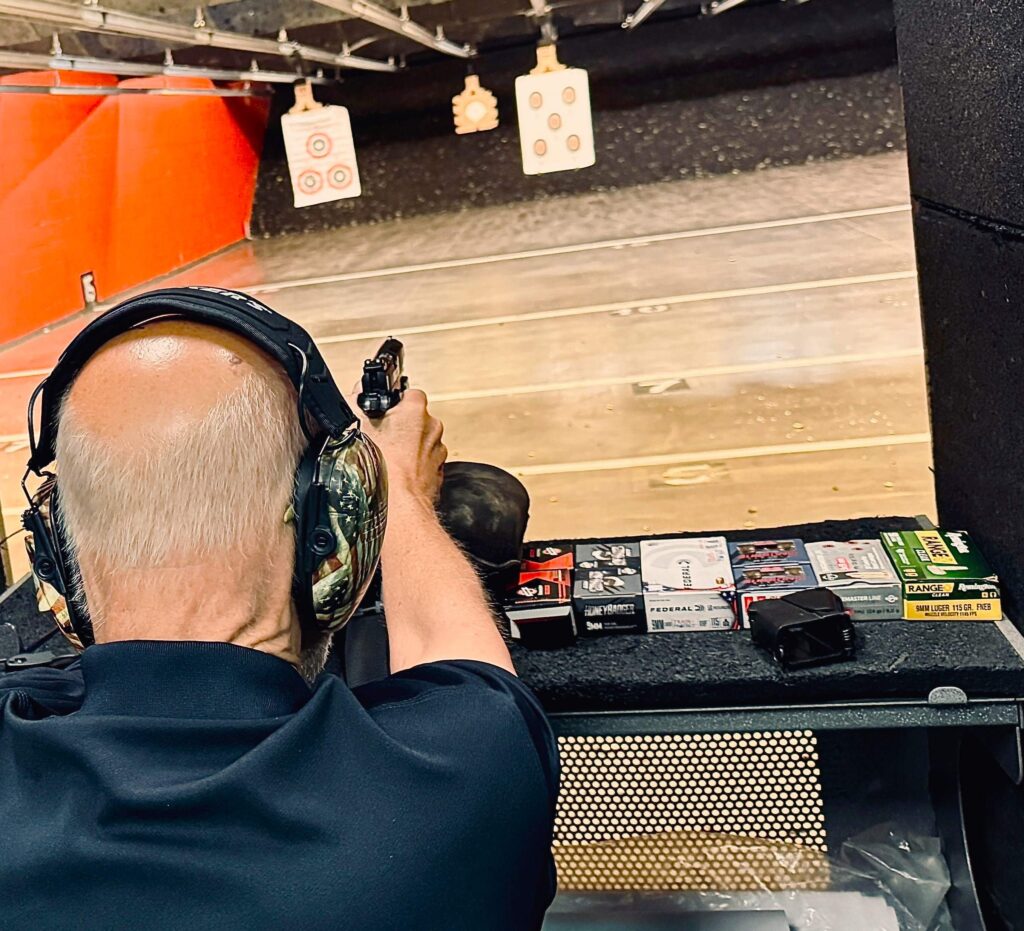
Six different 9mm loads were used to test the accuracy potential of the KDS9c Rail; shooting was done using a sandbag rest, at 15 yards.
At the range, I obtained velocity readings shooting the test ammunition through the Sky Screens of my Oehler Model 35P chronograph. Next, was an accuracy potential evaluation. Shooting was done from the bench, using a sandbag rest. The distance was 15 yards, and 7.5 x 5.5” oval-shaped targets were used for three 5-shot groups with each 9mm load. On several occasions a sub-1.5” group was ruined by a flyer attributable to the shooter. The official best 5-shot group came using the PPU Range Master 9mm cartridges, and measured 1.83.” Federal’s Train + Protect loads came in a close second, with a 1.87” cluster. The sights were shooting slightly right and low. All of the performance data is included the accompanying table. To check the reliability of the KDS9C Rail and to break it in a bit more, I fired a couple of magazines rapid-fire, at a distance of 7 yards.
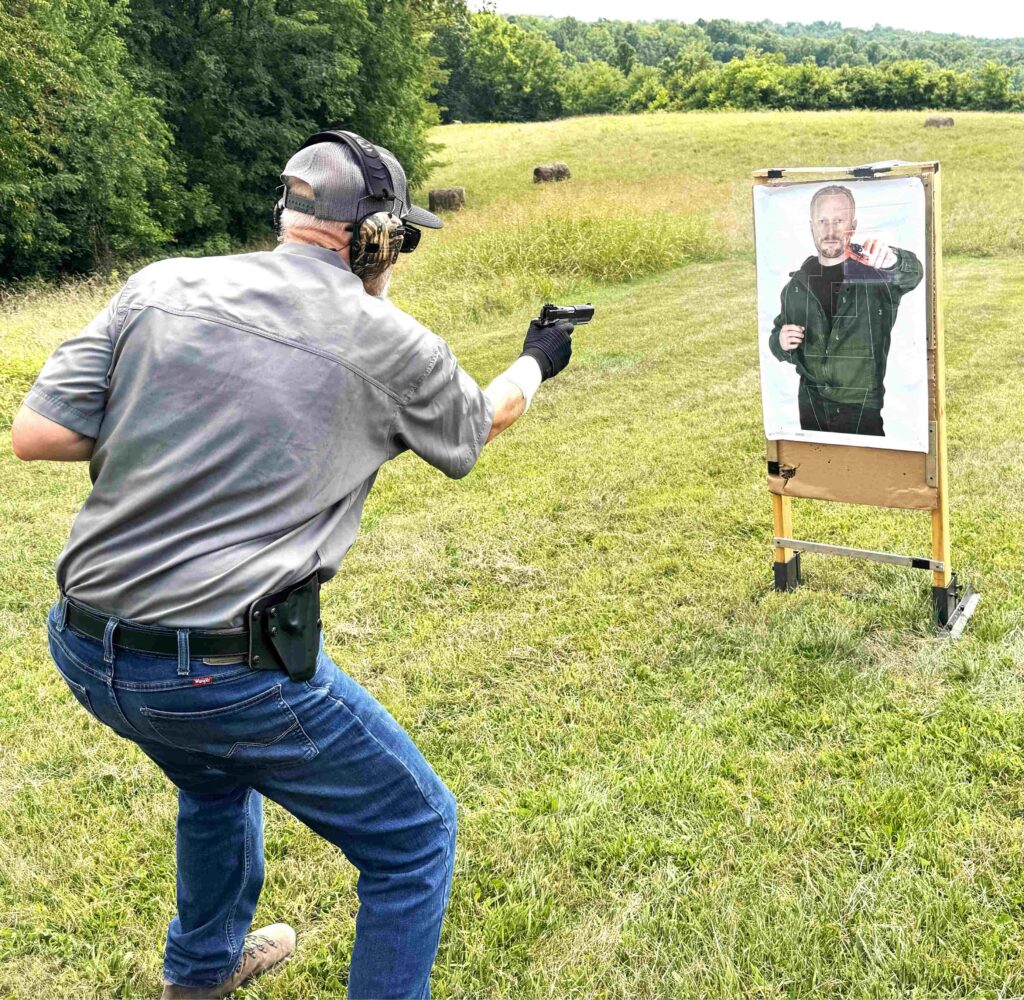
A 30-round combat was shot with the KDS9c-Rail; the first stage was at 3 yards; two stages were fired at 7 yards, and the last stage at 15 yards.
A 30-round combat course was shot using the PPU ammunition, and I loaded up the two Kimber magazines with 15 round each. I strapped on the belt, holster and magazine pouch, then chambered a round in the KDS9c Rail, and holstered it cocked and locked (Condition One). Just prior to that I removed the Streamlight tactical light. The 4 stage course is shot at 3, 7, and 15 yards. Each stage starts with the pistol holstered, and after the shooting, a 360° threat assessment is performed before the pistol is re-holstered. Shooting began at 3 yards without sights, using a one-handed hold, then transitioning from the primary to the support hand, for a total of 12 rounds. At 7 yards a double-tap drill is followed by a body armor/failure drill (2 center-mas and 1 head shot), for 12 more shots. The 15-yard stage is done using a barricade, but I substitued the front of my pickup truck as the barricade. A realistic “bad guy” silhouette target with 3-, 4- and 5-point scoring areas was utilized. Adding up my hits, I scored 138/150 points; with only one misdirected shot in the 3-zone.
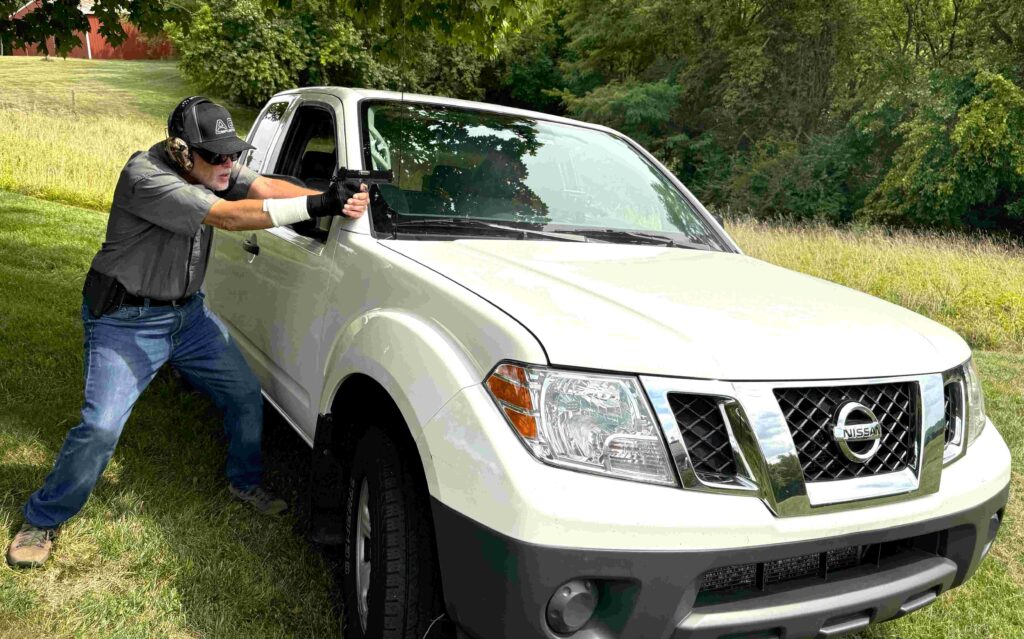
Instead of a barricade at 15 yards, the author used his pickup truck simulating a deadly force encounter in a parking lot.
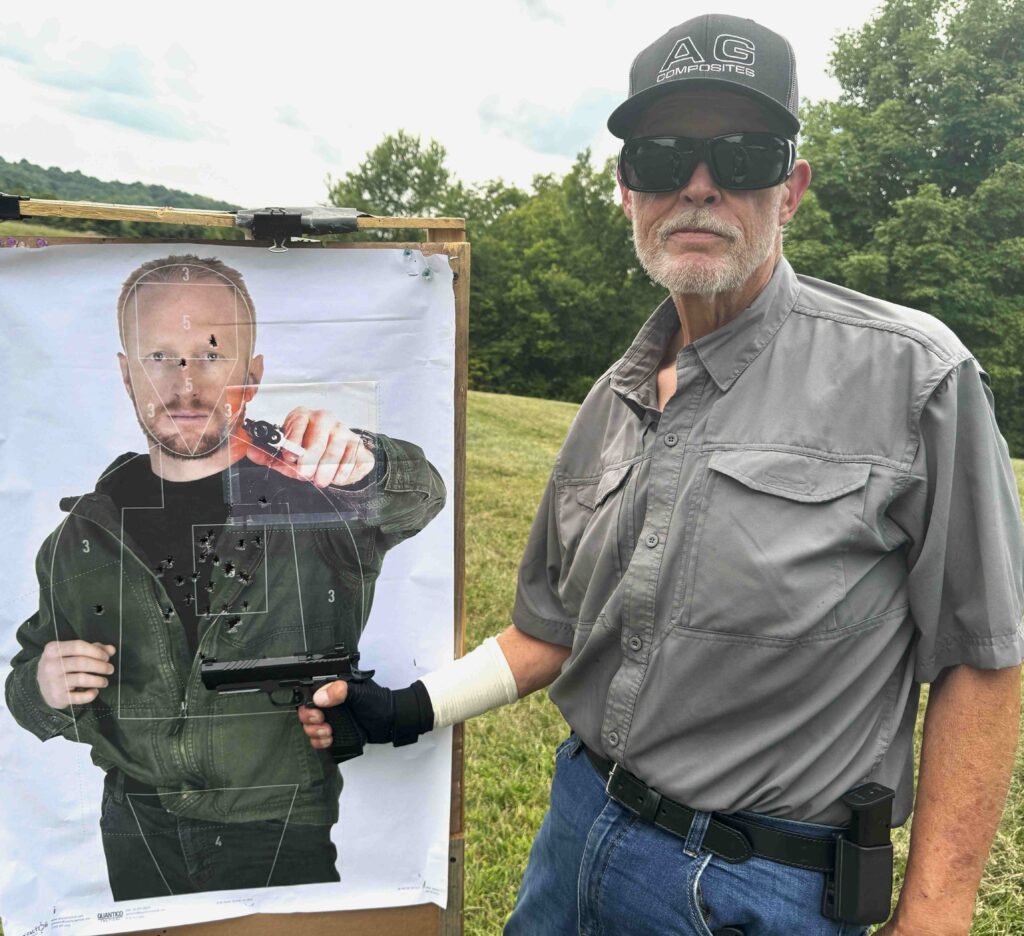
Here can be seen the results of the combat shooting course; only one shot strayed into the 3-Zone, the rest were in the 4 and 5-point “K-Zone.”
To be sure the Steamlight TLR-7 light would stay in place and function properly, I did the chronograph and accuracy testing with it attached to the KDS9c Rail. The pistol and light ran with no issues. I carried a Model 1911A1 pistol as a Reserve Officer with the Army, using in as a member of the Combat Pistol Team; I own two 1911 pistols, but still am not an aficionado. I will have to say that this Kimber 1911-style pistol is the most comfortable to hold and shoot than any other I’ve encountered. The controls were easy to reach with my thumb without having to shift my grip. Empty magazines ejected when the catch was pressed, there were zero malfunctions, and I didn’t have any issues manipulating the thumb safety, even though I do little Condition One shooting. If I was going to carry a 1911-type pistol for defense use, the Kimber KDS9c Rail would be it. For more information go to www.kimberamerica.com.
Kimber KDS9c Rail Specifications
MECHANISM: Single action, locked breech, short-recoil operation
CALIBER: 9mm Luger
CAPACITY: 15+1 and 18+1 cartridges
BARREL: 4.09”
OA LENGTH: 7.75”
EMPTY WEIGHT: 29.6 oz.
SIGHTS: TruGlo fixed front/rear night sights, optics ready
FINISH: Slide KimPro Black, frame KimPro Gray
STOCKS: Black crosshatch G10
MSRP: $1,903.00
KDS9c Rail 9mm Performance
| Cartridge | Ave. Velocity | Best Group | Average Group |
| Black Hills 100 gr. Honey Badger +P | 1,237 FPS | 2.26” | 3.08” |
| Black Hills Factory New 124 gr. JHP | 1,178 FPS | 2.77” | 3.62” |
| Federal Train + Protect 115 gr. V-JHP | 1,132 FPS | 1.87” | 2.65” |
| Hornady Subsonic 147 gr. XTP-HP | 949 FPS | 1.91” | 2.55” |
| PPU Rangemaster 124 gr. FMJ | 1,104 FPS | 1.83” | 2.49” |
| Remington Range 115 gr. FNEB* | 1,135 FPS | 2.21” | 2.65” |
NOTE: Bullet weight measured in grains, velocity in feet per second 10 ft. from the muzzle by an Oehler Model 35P chronograph, and accuracy in inches for three 5-shot groups at 15 yards. * FNEB: Flat-Nosed Enclosed Base
To locate a dealer near you visit www.lipseys.com/dealerfinder
